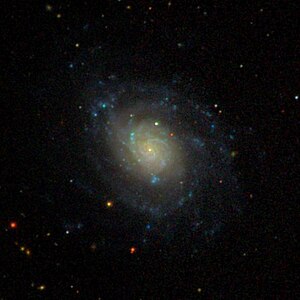NGC 4701
| Galaxy NGC 4701 |
|
|---|---|

|
|
| SDSS | |
| AladinLite | |
| Constellation | Virgin |
|
Position equinox : J2000.0 , epoch : J2000.0 |
|
| Right ascension | 12 h 49 m 11.6 s |
| declination | + 03 ° 23 ′ 19 ″ |
| Appearance | |
| Morphological type | SA (s) cd / HII |
| Brightness (visual) | 12.1 mag |
| Brightness (B-band) | 12.8 mag |
| Angular expansion | 2 ′, 8 × 2 ′, 1 |
| Position angle | 45 ° |
| Inclination | 43 ° |
| Surface brightness | 13.9 mag / arcmin² |
| Physical data | |
| Affiliation | Virgo I group Messier 49 group NGC 4636 group NGC 4343 group |
| Redshift | 0.002406 ± 0.000017 |
| Radial velocity | 721 ± 5 km / s |
|
Stroke distance v rad / H 0 |
(29 ± 2) · 10 6 ly (8.90 ± 0.63) Mpc |
| history | |
| discovery | Wilhelm Herschel |
| Discovery date | April 30, 1786 |
| Catalog names | |
| NGC 4701 • UGC 7975 • PGC 43331 • CGCG 043-034 • MCG + 01-33-015 • IRAS 12466 + 0339 • 2MASX J12491156 + 0323194 • GC 3231 • H II-578 • HIPASS J1249 + 03 • LDCE 904 NED256 • EVCC 1178 | |
NGC 4701 is a spiral-shaped dwarf galaxy with extensive star formation from Hubble type Sc in the constellation Virgo to the ecliptic . It is estimated to be 29 million light years from the Milky Way and about 25,000 light years across.
The galaxies NGC 4624 and NGC 4688 are located in the same area of the sky .
The object was discovered by William Herschel on April 30, 1786 .
literature
- Truong, et al. (2017): High-resolution Velocity Fields of Low-mass Disk Galaxies. I. CO Observations ; ApJ 843 (1)
